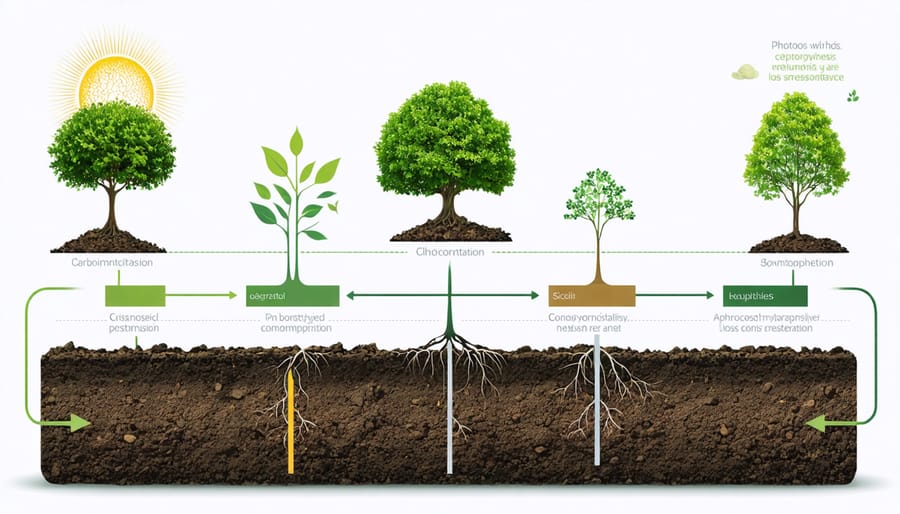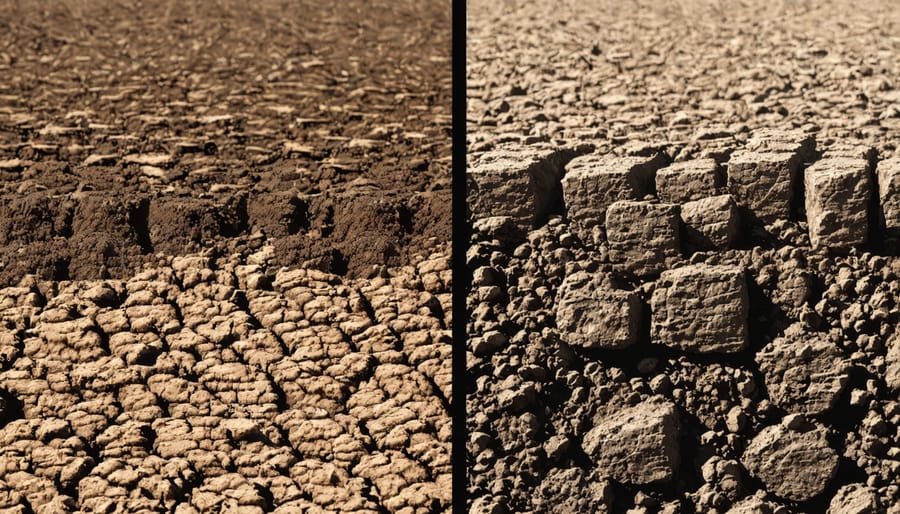Harness the power of soil carbon cycling to boost agricultural productivity and sustainability:
Introduce cover crops during fallow periods to add organic matter, prevent erosion, and fix atmospheric nitrogen in the soil.
Implement reduced or no-tillage practices to minimize soil disturbance, preserve soil structure, and promote carbon sequestration.
Apply compost, manure, or other organic amendments to provide nutrients, improve soil health, and enhance microbial activity vital for carbon cycling.
Adopt diverse crop rotations, including legumes and deep-rooted plants, to optimize nutrient cycling, break pest cycles, and build soil carbon reserves.

The Carbon Cycle in Soil
Photosynthesis and Decomposition
Plants play a vital role in soil carbon cycling through photosynthesis, converting atmospheric carbon dioxide into organic compounds that become part of the plant’s biomass. As plants shed leaves, roots, and other debris, this organic matter is added to the soil, contributing to its carbon content. Additionally, plant roots release sugars and other compounds that feed soil microbes, further promoting carbon storage.
Decomposition is the other crucial component of soil carbon cycling, driven by bacteria, fungi, and other microorganisms that break down dead plant material and other organic matter. During this process, some carbon is released back into the atmosphere as CO2, while the rest is converted into more stable forms like humus, which can remain in the soil for decades or even centuries. Factors like soil temperature, moisture, and nutrient availability influence the rate of decomposition and the balance between carbon storage and release.
By understanding these processes, farmers in Alberta can adopt practices that optimize soil carbon cycling, such as minimizing tillage to preserve soil structure and reduce carbon loss, planting cover crops to add organic matter, and managing crop residues to enhance carbon input. These strategies not only support soil health but also contribute to climate change mitigation by sequestering atmospheric carbon in agricultural soils.
Respiration and Other Losses
Carbon leaves the soil through various processes, notably microbial and root respiration, erosion, and leaching. In Alberta’s agricultural soils, respiration is a significant pathway for carbon loss. As microorganisms break down organic matter and plant roots release CO2, carbon is returned to the atmosphere. Tillage practices can accelerate this process by exposing more soil to oxygen. Erosion, particularly on slopes or during heavy rainfall events, can physically remove carbon-rich topsoil. Leaching occurs when dissolved organic carbon is carried away by water moving through the soil profile. While some carbon loss is natural, minimizing tillage, maintaining plant cover, and improving soil structure can help reduce these losses in Alberta’s diverse agricultural landscapes. By understanding and managing these pathways, farmers can work towards more resilient and productive soils that retain carbon and support healthy ecosystems.
Benefits of Soil Carbon
Soil Structure and Fertility
Carbon plays a vital role in improving soil structure and fertility. As organic matter decomposes, it releases carbon compounds that act as glue, binding soil particles together to form stable aggregates. This process enhances soil structure, allowing for better water infiltration, drainage, and aeration. Well-aggregated soils also have a higher water holding capacity, reducing the risk of drought stress and improving plant growth.
In addition to its structural benefits, carbon is essential for soil fertility. As microorganisms break down organic matter, they release nutrients like nitrogen, phosphorus, and potassium, making them available for plant uptake. This natural nutrient cycling reduces the need for synthetic fertilizers and supports healthy crop growth. Carbon-rich soils also have a higher cation exchange capacity (CEC), allowing them to retain more nutrients and prevent leaching. By prioritizing practices that increase soil carbon, such as conservation tillage, cover cropping, and composting, Alberta farmers can enhance both soil structure and fertility for long-term agricultural sustainability.

Climate Change Mitigation
Soil plays a vital role as a carbon sink, absorbing and storing atmospheric carbon dioxide. By adopting sustainable farming practices, we can enhance this natural process and contribute to climate change mitigation. Practices like reduced tillage, cover cropping, and diverse crop rotations help increase soil organic matter, which in turn sequesters more carbon. Additionally, managing grazing lands to promote healthy plant growth and root systems can further boost carbon storage. As stewards of the land, we have the power to make a positive impact. By working together and sharing knowledge, we can optimize our soil’s potential to combat climate change while also improving soil health and productivity. Every small step counts, and by embracing these practices, we not only secure a more sustainable future for our farms but also contribute to the well-being of our planet and future generations.

Practices to Enhance Soil Carbon
Reduced Tillage
Reduced tillage practices, such as no-till or strip-till, minimize soil disturbance and help preserve carbon in the soil. When soil is tilled, it exposes stored carbon to the air, allowing it to escape as carbon dioxide. By reducing tillage intensity and frequency, more carbon remains sequestered in the soil. For best results, use equipment designed for low soil disturbance, like no-till drills or strip-till rigs. Time tillage operations carefully, avoiding wet conditions that can lead to compaction. Aim to keep soil covered with crop residue or cover crops year-round. These practices not only retain carbon but also improve soil structure, water infiltration, and nutrient cycling, leading to healthier, more productive soil over time.
Cover Cropping
Cover crops are an essential tool for improving soil carbon cycling in Alberta. By planting cover crops between main crop rotations, farmers can add significant amounts of biomass to the soil, which breaks down into organic matter and feeds beneficial microbes. This process helps sequester carbon, prevent erosion, suppress weeds, and enhance overall soil health. Some recommended cover crop species for Alberta include legumes like field peas, fava beans, and red clover, which fix nitrogen and improve soil fertility. Other beneficial options are cereal rye, oats, and tillage radish, known for their extensive root systems that help break up compacted soils and scavenge nutrients. By incorporating a diverse mix of cover crops tailored to their specific needs, Alberta farmers can optimize soil carbon cycling and reap the numerous benefits of this sustainable practice.
Composting and Amendments
Composting is an effective way to build soil carbon by recycling organic matter back into the earth. To start, collect materials like food scraps, yard trimmings, and animal manures in a designated bin or pile. Aim for a mix of green (nitrogen-rich) and brown (carbon-rich) materials, maintaining a ratio of about 1:2. Keep the pile moist but not soggy, and turn it regularly to introduce oxygen and speed up decomposition. Once the compost resembles dark, crumbly soil, it’s ready to use as a nutrient-rich amendment.
In Alberta, many municipalities offer composting programs and workshops. Check with your local waste management authority for details. You can also source amendments like aged manure, wood chips, and straw from nearby farms, stables, or landscaping companies. Remember, a little goes a long way—apply amendments judiciously to avoid over-fertilizing and potential nutrient runoff.
Crop Rotation
Crop rotation is a powerful tool for improving soil carbon cycling in Alberta. By alternating diverse crops, particularly perennials and legumes, farmers can enhance soil health and carbon sequestration. Perennials, like alfalfa or grass-legume mixtures, develop extensive root systems that add organic matter to the soil. Legumes, such as peas or lentils, fix atmospheric nitrogen and improve soil fertility. A sample rotation for Alberta might include canola, wheat, peas, and alfalfa. Another option is barley, field peas, and a grass-legume mix. Aim for at least three different crop types and include a perennial or legume every few years. Diverse rotations support soil microbes, improve nutrient cycling, and increase soil carbon storage. Consult local agricultural experts to develop a rotation plan tailored to your farm’s unique conditions.
Conclusion
Soil carbon cycling offers a powerful opportunity to enhance agricultural productivity while supporting environmental health. By implementing practices like cover cropping, reduced tillage, and diverse crop rotations, farmers can boost soil organic matter, improve nutrient cycling, and create more resilient farmland. The benefits extend beyond the farm gate, with increased soil carbon storage helping to mitigate climate change. Adopting these strategies is a win-win for farmers, enabling them to build soil health, increase yields, and contribute to a more sustainable future. As stewards of the land, the agricultural community has a vital role to play in optimizing soil carbon cycling. Every farmer can make a difference, no matter the size of their operation. We encourage all readers to explore how they can integrate these practices on their farms, working together to create a thriving and resilient agricultural landscape in Alberta and beyond. The time to act is now – for the health of our soils, our farms, and our planet.










